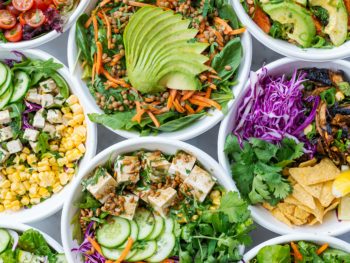As a registered dietitian nutritionist (RDN) counseling clients trying to get healthy and shed a few pounds, a big challenge I face is helping them control their portion sizes. My fellow RDNs face such challenges too. I, therefore, was invited to contribute this post for Today’s Dietitian blog, “RD Lounge.” You can also read it below. My suggestions apply both to educators and to consumers looking to get a better handle on portion sizes.
————————————————————————————————————————————————————————
Do your clients have difficulty managing their portion sizes? As an RDN in private practice for more than 20 years, I see it every day. Controlling portion sizes is one of the biggest challenges my clients face when trying to shed a few pounds. Portion sizes have increased in recent years, distorting our perception of how much food is enough so that most people don’t even realize they are eating oversized portions. Large portions can contribute to weight gain not just by containing more calories than smaller portions but also by encouraging people to eat more food and underestimate how much they’re eating.
Here are five ways to help your clients control their portions.
1. Write it before you bite it. Ask your clients to keep track of what—and how much—they eat. Tracking food intake for a month or so helps us be honest about all the nibbles and snacks we may have forgotten about. And it’s a great way to end “perception deception”—thinking that we eat more healthful foods and fewer unhealthful foods than we actually do.
2. Use your hand as a guide. Measuring portion sizes is important, at least until we get a handle on how big our portions should be. While it’s not likely that clients will bring a measuring cup to their favorite restaurant, teaching them to use their hand as a portion guide is simple, far less intrusive, and a good benchmark for how much to eat of certain foods.
A portion of chicken or fish should be about the size of the palm, a side of rice or quinoa should be about the size a fist, and a portion of cheese (1 to 2 oz) should be the size of one to two fingers, not all 10. While this method isn’t an exact science, it does come in handy and is fairly accurate. A client with a bigger hand, for instance, can probably eat a little more than one with a smaller hand.
3. Practice plate therapy. Plate sizes have increased in recent years and this translates to piling on bigger portions—and more calories. Rather than suggest your clients buy a new set of dishes, try this one trick: suggest that clients eat their salad off of a large plate and foods they should portion control (such as meat and potatoes) off of a smaller salad or dessert plate. It’s a great way to get in more produce and less meat. While this trick probably can’t be done in a restaurant, it’s great to try at home.
4. Pile on the produce. Let’s face it, many of our clients don’t want to eat less. And sometimes they don’t have to. Relatively low in calories and high in nutrients, fruits and vegetables should take up one-half of the plate. Piling on the produce gives clients just enough room on their plate for a healthful portion of protein and grains.
5. Make your portions count and enjoy the company you keep. The beauty of portion control is that it isn’t a diet but a lifestyle. It’s less about what we eat and more about our relationship with food. All foods can fit into the plan provided we see them from the perspective of portion control.
With that in mind, I advocate that clients allow themselves to indulge, on occasion, in a small portion of foods they love (ice cream, anyone?). Equally important is to eat mindfully, enjoy the social aspects of our meal, and get everyone involved in cooking and cleaning up.





 5 lifestyle factors that may influence our food choices
5 lifestyle factors that may influence our food choices